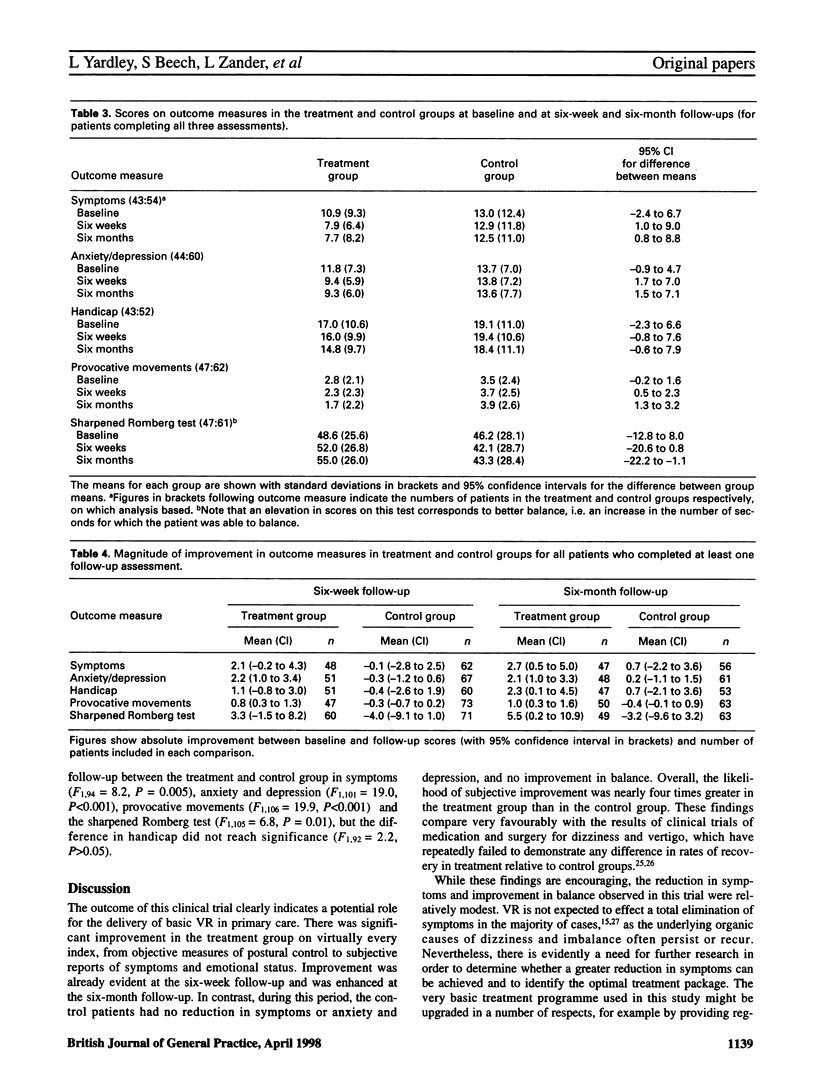Abstract
BACKGROUND: 'Vestibular rehabilitation' (VR) is an increasingly popular treatment option for patients with persistent dizziness. Previous clinical trials have only evaluated the effects of specialist therapy programmes in small, selective, or uncontrolled patient samples. AIM: To determine the benefits of VR compared with standard medical care, using a brief intervention for dizzy patients in primary care. METHOD: Adults consulting their general practitioner (GP) with dizziness or vertigo were randomly assigned to treatment or control groups. Patients in both groups received the same evaluation at baseline, six-week follow-up, and six-month follow-up, comprising examination of nystagmus, postural control, and movement-provoked dizziness, and a questionnaire assessment of subjective status, symptoms, handicap, anxiety, and depression. At baseline and six weeks later, the treatment group also received an individualized 30-minute therapy session, in which they were taught head, eye, and body exercises designed to promote vestibular compensation and enhance skill and confidence in balance. RESULTS: The treatment group (n = 67) improved on all measures, whereas the control group (n = 76) showed no improvement, resulting in a significant difference between the two groups on physical indices of balance and subjective indices of symptoms and distress. Odds ratios for improvement in treated patients relative to untreated patients were 3.1:1 at six weeks (95% CI = 1.4-6.8) and 3.8:1 at six months (95% CI = 1.6-8.7). CONCLUSION: VR is a simple, inexpensive, and beneficial treatment, and may be an appropriate first stage of management for many dizzy patients in primary care.
Full text
PDF




Selected References
These references are in PubMed. This may not be the complete list of references from this article.
- Cohen H. Vestibular rehabilitation reduces functional disability. Otolaryngol Head Neck Surg. 1992 Nov;107(5):638–643. doi: 10.1177/019459989210700505. [DOI] [PubMed] [Google Scholar]
- Colledge N. R., Barr-Hamilton R. M., Lewis S. J., Sellar R. J., Wilson J. A. Evaluation of investigations to diagnose the cause of dizziness in elderly people: a community based controlled study. BMJ. 1996 Sep 28;313(7060):788–792. doi: 10.1136/bmj.313.7060.788. [DOI] [PMC free article] [PubMed] [Google Scholar]
- Fujino A., Tokumasu K., Yosio S., Naganuma H., Yoneda S., Nakamura K. Vestibular training for benign paroxysmal positional vertigo. Its efficacy in comparison with antivertigo drugs. Arch Otolaryngol Head Neck Surg. 1994 May;120(5):497–504. doi: 10.1001/archotol.1994.01880290013003. [DOI] [PubMed] [Google Scholar]
- Grimby A., Rosenhall U. Health-related quality of life and dizziness in old age. Gerontology. 1995;41(5):286–298. doi: 10.1159/000213696. [DOI] [PubMed] [Google Scholar]
- Horak F. B., Jones-Rycewicz C., Black F. O., Shumway-Cook A. Effects of vestibular rehabilitation on dizziness and imbalance. Otolaryngol Head Neck Surg. 1992 Feb;106(2):175–180. [PubMed] [Google Scholar]
- Keim R. J., Cook M., Martini D. Balance rehabilitation therapy. Laryngoscope. 1992 Nov;102(11):1302–1307. doi: 10.1288/00005537-199211000-00019. [DOI] [PubMed] [Google Scholar]
- Kroenke K., Lucas C. A., Rosenberg M. L., Scherokman B., Herbers J. E., Jr, Wehrle P. A., Boggi J. O. Causes of persistent dizziness. A prospective study of 100 patients in ambulatory care. Ann Intern Med. 1992 Dec 1;117(11):898–904. doi: 10.7326/0003-4819-117-11-898. [DOI] [PubMed] [Google Scholar]
- McKee G. J., Kerr A. G., Toner J. G., Smyth G. D. Surgical control of vertigo in Ménière's disease. Clin Otolaryngol Allied Sci. 1991 Apr;16(2):216–227. doi: 10.1111/j.1365-2273.1991.tb01980.x. [DOI] [PubMed] [Google Scholar]
- Rascol O., Hain T. C., Brefel C., Benazet M., Clanet M., Montastruc J. L. Antivertigo medications and drug-induced vertigo. A pharmacological review. Drugs. 1995 Nov;50(5):777–791. doi: 10.2165/00003495-199550050-00002. [DOI] [PubMed] [Google Scholar]
- Rudge P., Bronstein A. M. Investigations of disorders of balance. J Neurol Neurosurg Psychiatry. 1995 Dec;59(6):568–578. doi: 10.1136/jnnp.59.6.568. [DOI] [PMC free article] [PubMed] [Google Scholar]
- Shepard N. T., Telian S. A., Smith-Wheelock M. Habituation and balance retraining therapy. A retrospective review. Neurol Clin. 1990 May;8(2):459–475. [PubMed] [Google Scholar]
- Shepard N. T., Telian S. A., Smith-Wheelock M., Raj A. Vestibular and balance rehabilitation therapy. Ann Otol Rhinol Laryngol. 1993 Mar;102(3 Pt 1):198–205. doi: 10.1177/000348949310200306. [DOI] [PubMed] [Google Scholar]
- Sloane P. D., Dallara J., Roach C., Bailey K. E., Mitchell M., McNutt R. Management of dizziness in primary care. J Am Board Fam Pract. 1994 Jan-Feb;7(1):1–8. [PubMed] [Google Scholar]
- Sloane P. D. Dizziness in primary care. Results from the National Ambulatory Medical Care Survey. J Fam Pract. 1989 Jul;29(1):33–38. [PubMed] [Google Scholar]
- Steenerson R. L., Cronin G. W. Comparison of the canalith repositioning procedure and vestibular habituation training in forty patients with benign paroxysmal positional vertigo. Otolaryngol Head Neck Surg. 1996 Jan;114(1):61–64. doi: 10.1016/S0194-59989670284-X. [DOI] [PubMed] [Google Scholar]
- Tinetti M. E., Williams T. F., Mayewski R. Fall risk index for elderly patients based on number of chronic disabilities. Am J Med. 1986 Mar;80(3):429–434. doi: 10.1016/0002-9343(86)90717-5. [DOI] [PubMed] [Google Scholar]
- Weindruch R., Korper S. P., Hadley E. The prevalence of dysequilibrium and related disorders in older persons. Ear Nose Throat J. 1989 Dec;68(12):925–929. [PubMed] [Google Scholar]
- Yardley L. Contribution of symptoms and beliefs to handicap in people with vertigo: a longitudinal study. Br J Clin Psychol. 1994 Feb;33(Pt 1):101–113. doi: 10.1111/j.2044-8260.1994.tb01100.x. [DOI] [PubMed] [Google Scholar]
- Yardley L., Luxon L. Treating dizziness with vestibular rehabilitation. BMJ. 1994 May 14;308(6939):1252–1253. doi: 10.1136/bmj.308.6939.1252. [DOI] [PMC free article] [PubMed] [Google Scholar]
- Yardley L., Masson E., Verschuur C., Haacke N., Luxon L. Symptoms, anxiety and handicap in dizzy patients: development of the vertigo symptom scale. J Psychosom Res. 1992 Dec;36(8):731–741. doi: 10.1016/0022-3999(92)90131-k. [DOI] [PubMed] [Google Scholar]
- Yardley L., Owen N., Nazareth I., Luxon L. Prevalence and presentation of dizziness in a general practice community sample of working age people. Br J Gen Pract. 1998 Apr;48(429):1131–1135. [PMC free article] [PubMed] [Google Scholar]
- Yardley L., Putman J. Quantitative analysis of factors contributing to handicap and distress in vertiginous patients: a questionnaire study. Clin Otolaryngol Allied Sci. 1992 Jun;17(3):231–236. doi: 10.1111/j.1365-2273.1992.tb01833.x. [DOI] [PubMed] [Google Scholar]
- Zigmond A. S., Snaith R. P. The hospital anxiety and depression scale. Acta Psychiatr Scand. 1983 Jun;67(6):361–370. doi: 10.1111/j.1600-0447.1983.tb09716.x. [DOI] [PubMed] [Google Scholar]


